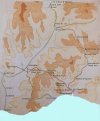Watermouth is supposedly located somewhere on the South Devon/West Dorset coast. It is likely that Pat English took Weymouth as inspiration for his fictitious terminus. Adding a docks branch to a supposed passenger embarkation terminal, opened up interesting possibilities for additional traffic including Boat Trains.
The map below shows the routes to Watermouth by both GWR and Southern lines.

The main route was supposedly built by the Bristol & Exeter Railway from Taunton via Chard originally as Broad Gauge, establishing their foothold on the coast long before the LSWR began extending their system westwards. Although shown as GWR (red), the western route from Axminster was the LSWR's line, although the GWR exercised running powers over it to reach their isolated branchline from Axminster Road to Kilmington. Despite the GWR having the monopoly, the LSWR pressed ahead and constructed their own branch via Axminster with the intention of obtaining running powers over the B & E's timber viaduct across the estuary to Watermouth. The B & E by this time had been absorbed by the GWR and they cited lack of capacity over the single line bridge, thus successfully blocking the LSWR from reaching their terminus and forcing them to construct their own terminus on the north bank of the river. This was then known as Watermouth St. David's. The B & E and later GWR tended to follow a tank engines policy on the branch and so a turntable at Watermouth was not provided, nor was there room for one, causing some problems when the GWR began to introduce larger tender engines to cope with the increasing docks trade. The LSWR had always followed (some would say sensibly) a tender locomotive policy for its route, and so had installed a locomotive servicing point with a 55' turntable close to its station. Following an eventual thaw in relations between the two companies and the reconstruction of the old timber bridge with an iron one, an agreement was reached allowing LSWR (later SR) trains to run into Watermouth Town in return for the GWR's need to use the their MPD with its turntable at Watermouth St. Davids. The station was retained for use by residents living on the north bank and was eventually renamed St. David's Junction in recognition of the dividing point of the two routes.

Schematic diagram of Watermouth terminus. The Docks branch diverged at points 25.
The map below shows the routes to Watermouth by both GWR and Southern lines.

The main route was supposedly built by the Bristol & Exeter Railway from Taunton via Chard originally as Broad Gauge, establishing their foothold on the coast long before the LSWR began extending their system westwards. Although shown as GWR (red), the western route from Axminster was the LSWR's line, although the GWR exercised running powers over it to reach their isolated branchline from Axminster Road to Kilmington. Despite the GWR having the monopoly, the LSWR pressed ahead and constructed their own branch via Axminster with the intention of obtaining running powers over the B & E's timber viaduct across the estuary to Watermouth. The B & E by this time had been absorbed by the GWR and they cited lack of capacity over the single line bridge, thus successfully blocking the LSWR from reaching their terminus and forcing them to construct their own terminus on the north bank of the river. This was then known as Watermouth St. David's. The B & E and later GWR tended to follow a tank engines policy on the branch and so a turntable at Watermouth was not provided, nor was there room for one, causing some problems when the GWR began to introduce larger tender engines to cope with the increasing docks trade. The LSWR had always followed (some would say sensibly) a tender locomotive policy for its route, and so had installed a locomotive servicing point with a 55' turntable close to its station. Following an eventual thaw in relations between the two companies and the reconstruction of the old timber bridge with an iron one, an agreement was reached allowing LSWR (later SR) trains to run into Watermouth Town in return for the GWR's need to use the their MPD with its turntable at Watermouth St. Davids. The station was retained for use by residents living on the north bank and was eventually renamed St. David's Junction in recognition of the dividing point of the two routes.

Schematic diagram of Watermouth terminus. The Docks branch diverged at points 25.
